Overpopulation Overpopulation is not the problem The New York
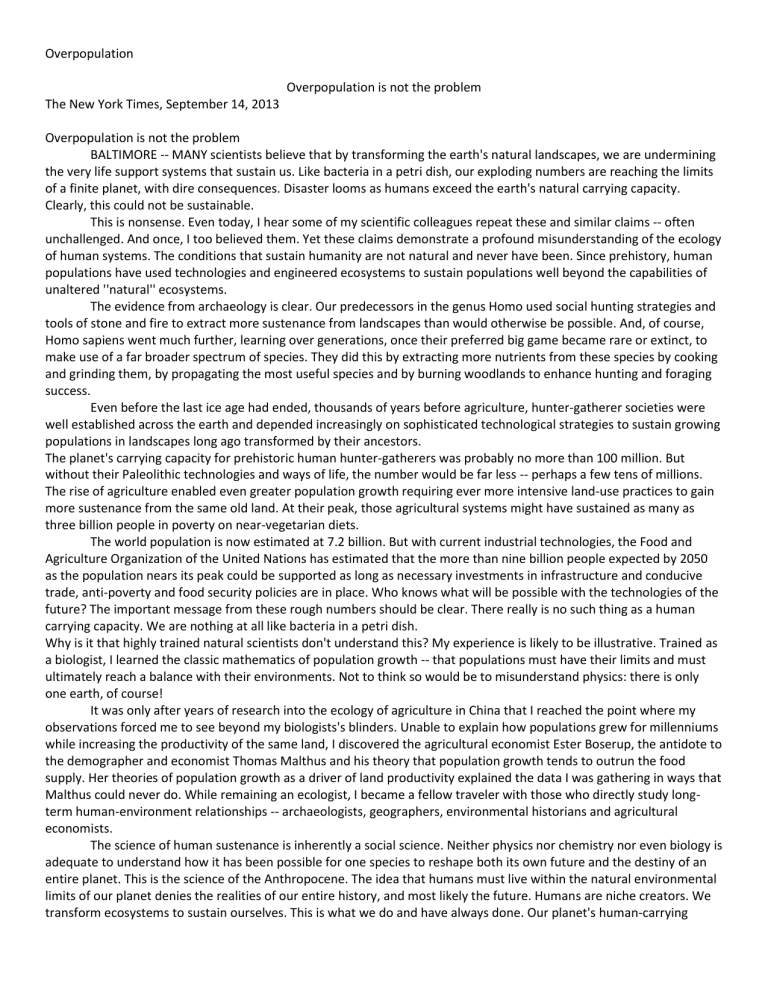
Overpopulation
Overpopulation is not the problem
The New York Times, September 14, 2013
Overpopulation is not the problem
BALTIMORE -- MANY scientists believe that by transforming the earth's natural landscapes, we are undermining the very life support systems that sustain us. Like bacteria in a petri dish, our exploding numbers are reaching the limits of a finite planet, with dire consequences. Disaster looms as humans exceed the earth's natural carrying capacity.
Clearly, this could not be sustainable.
This is nonsense. Even today, I hear some of my scientific colleagues repeat these and similar claims -- often unchallenged. And once, I too believed them. Yet these claims demonstrate a profound misunderstanding of the ecology of human systems. The conditions that sustain humanity are not natural and never have been. Since prehistory, human populations have used technologies and engineered ecosystems to sustain populations well beyond the capabilities of unaltered ''natural'' ecosystems.
The evidence from archaeology is clear. Our predecessors in the genus Homo used social hunting strategies and tools of stone and fire to extract more sustenance from landscapes than would otherwise be possible. And, of course,
Homo sapiens went much further, learning over generations, once their preferred big game became rare or extinct, to make use of a far broader spectrum of species. They did this by extracting more nutrients from these species by cooking and grinding them, by propagating the most useful species and by burning woodlands to enhance hunting and foraging success.
Even before the last ice age had ended, thousands of years before agriculture, hunter-gatherer societies were well established across the earth and depended increasingly on sophisticated technological strategies to sustain growing populations in landscapes long ago transformed by their ancestors.
The planet's carrying capacity for prehistoric human hunter-gatherers was probably no more than 100 million. But without their Paleolithic technologies and ways of life, the number would be far less -- perhaps a few tens of millions.
The rise of agriculture enabled even greater population growth requiring ever more intensive land-use practices to gain more sustenance from the same old land. At their peak, those agricultural systems might have sustained as many as three billion people in poverty on near-vegetarian diets.
The world population is now estimated at 7.2 billion. But with current industrial technologies, the Food and
Agriculture Organization of the United Nations has estimated that the more than nine billion people expected by 2050 as the population nears its peak could be supported as long as necessary investments in infrastructure and conducive trade, anti-poverty and food security policies are in place. Who knows what will be possible with the technologies of the future? The important message from these rough numbers should be clear. There really is no such thing as a human carrying capacity. We are nothing at all like bacteria in a petri dish.
Why is it that highly trained natural scientists don't understand this? My experience is likely to be illustrative. Trained as a biologist, I learned the classic mathematics of population growth -- that populations must have their limits and must ultimately reach a balance with their environments. Not to think so would be to misunderstand physics: there is only one earth, of course!
It was only after years of research into the ecology of agriculture in China that I reached the point where my observations forced me to see beyond my biologists's blinders. Unable to explain how populations grew for millenniums while increasing the productivity of the same land, I discovered the agricultural economist Ester Boserup, the antidote to the demographer and economist Thomas Malthus and his theory that population growth tends to outrun the food supply. Her theories of population growth as a driver of land productivity explained the data I was gathering in ways that
Malthus could never do. While remaining an ecologist, I became a fellow traveler with those who directly study longterm human-environment relationships -- archaeologists, geographers, environmental historians and agricultural economists.
The science of human sustenance is inherently a social science. Neither physics nor chemistry nor even biology is adequate to understand how it has been possible for one species to reshape both its own future and the destiny of an entire planet. This is the science of the Anthropocene. The idea that humans must live within the natural environmental limits of our planet denies the realities of our entire history, and most likely the future. Humans are niche creators. We transform ecosystems to sustain ourselves. This is what we do and have always done. Our planet's human-carrying
Overpopulation capacity emerges from the capabilities of our social systems and our technologies more than from any environmental limits.
Two hundred thousand years ago we started down this path. The planet will never be the same. It is time for all of us to wake up to the limits we really face: the social and technological systems that sustain us need improvement.
There is no environmental reason for people to go hungry now or in the future. There is no need to use any more land to sustain humanity -- increasing land productivity using existing technologies can boost global supplies and even leave more land for nature -- a goal that is both more popular and more possible than ever.
The only limits to creating a planet that future generations will be proud of are our imaginations and our social systems.
In moving toward a better Anthropocene, the environment will be what we make it.
Source Citation
Ellis, Erle C. "Overpopulation is not the problem." New York Times 14 Sept. 2013: A19(L). Opposing Viewpoints in
Context. Web. 4 Jan. 2014.
The Problem of Overpopulation Is Exaggerated
What Is Humanity's Greatest Challenge?, 2010
Philip P. Eapen is a Bible teacher and relief worker based in India.
Warnings against overpopulation are based on unsubstantiated claims, misconceptions, and doomsday predictions. For instance, the so-called population boom of the twentieth century is due to medical advances that have decreased infant mortality and prolonged human life expectancy, not spiraling birth rates in developing countries.
Moreover, developed nations are among the most crowded, global food production is not in danger of being surpassed by consumption, and the planet's reserves of minerals, fossil fuels, and other raw materials are in ample supply. In reality, humans are living longer and better. Fears and concerns of overpopulation do not stand up to the facts.
World population reached six billion in the year 1999 and an estimated 83 million people are being added to that number every year since. Population growth was rather slow for most of human history. Famines, war, epidemics and high infant mortality rates ensured that population growth was negligible. Advancement in agriculture, food distribution and trade in the seventeenth century gave rise to a faster population growth in Europe.
The world population reached one billion by the beginning of nineteenth century. During the nineteenth century, Europe's population doubled; Europeans spilled over to North America, South Africa, Australia, New Zealand, and other colonies they held in Latin America and Asia. The twentieth century began with a population of 1.7 billion after which world population saw a sudden increase, reaching two billion by 1930, three billion by 1960, four billion by
1974, five billion by 1986, and six billion by 1999....
Taking population density into account, we get a more accurate picture of human population distribution in relation to total available land in every country or continent. This parameter will indicate that Asian and African countries are "people rich" while North America and Australia are "land rich." Very often, the perceived "population explosion" in Asian and African countries is about the high population density—or crowding—in these lands. Many
European or developed regions are as crowded as some Asian countries while some Asian countries that have large populations have lower population densities. For example, the United Kingdom is more crowded than China; Germany is more densely populated than Pakistan!
There are several common reasons given in support of population control operations. These will be evaluated in the light of recent findings on the state of the world's resources, environment and on the real nature of "family planning" implemented in various developing countries. The following subsections explore common reasons that answer the question, "Why should we control population?"
Early Warnings
An early warning about uncontrolled global population growth came from Rev. Thomas Robert Malthus, the
English political economist who wrote an "Essay on the Principle of Population" in 1798. The central thesis of this essay is that "population, when unchecked, increases in a geometrical ratio; and subsistence for man, in an arithmetical ratio."
He argues that unless population growth is checked, humankind would soon face starvation. His views received wide acceptance especially among the upper classes of society because these "tended to relieve the rich and powerful of
Overpopulation responsibility for the condition of the working classes, by showing that the latter had chiefly themselves to blame...." A direct consequence of Malthusian views was a decreased interest shown by rulers for uplifting the poor. The rulers of the nineteenth century believed that "increased comfort would lead to an increase in numbers." Thus, poverty was considered to be a restraining mechanism that would curb the tendency of the poor to multiply.
The United Kingdom is more crowded than China; Germany is more densely populated than Pakistan!
Before Malthus, the Rev. Otto Diederich Lutken, in 1758, sought to dispel the idea that the prosperity of a state depended on its increasing population. He wrote,
Since the circumference of the globe is given and does not expand with the increased number of its inhabitants,... since the earth's fertility cannot be extended beyond a given point, and since human nature will presumably remain unchanged, so that a given number will hereafter require the same quantity of the fruits of the earth for their support as now, and as their rations cannot be arbitrarily reduced, it follows that ... they must needs starve one another out....
The "Cancer" of Human Multiplication
[Professor] Paul Ehrlich's Population Bomb popularised Malthusian fears and predicted that the world would witness large scale starvation deaths in the 1970s. Ehrlich favoured coercive measures to control the "cancer" of human multiplication. Environmental agencies carry forward the Malthusian hypothesis with great zeal. An ardent supporter of
Malthusian predictions once exclaimed, "If you are not hysterical, that just shows that you do not understand the problem."
The US Government organised an exhibition in the 1970s for school children in various parts of the country. It sought to spread this message:
There are too many people in the world. We are running out of space. We are running out of energy. We are running out of food. And, although too few people seem to realize it, we are running out of time.
The Worldwatch State of the World report of 1998 expressed fears that the world is on the threshold of a large scale shortage of grain. It claims that the world grain productivity slowed down in the 1990s; a bleak picture of scarcity is portrayed in the report. [Worldwatch Institute founder Lester R.] Brown calls for major investments in agriculture as well as in population control.
Closely related to the worry about shortage of food is the worry about running short of resources such as forests, energy, mineral resources, and water. Rev. Lutken had mentioned this in his writing on the adverse effects of a growing population—the "other necessarily attendant inconveniences, to wit, a lack of the other comforts of life, wool, flax, timber, fuel, and so on." Therefore, he concludes that ... the wise Creator who commanded men in the beginning to be fruitful and multiply, did not intend, since He set limits to their habitation and sustenance, that multiplication should continue without limit.
How True Are Doomsday Predictions?
Over the past years there has been no dearth for doomsday predictions. The message that the world is going from bad to worse is so widespread and taken for granted in many quarters. The pertinent question is, how sure are we about our estimates of the carrying capacity of planet Earth? How true are these doomsday predictions?
Worldwatch Institute presents a gloomy picture of the world in its State of the World report:
While economic indicators ... are consistently positive, the key environmental indicators are increasingly negative.
Forests are shrinking, water tables are falling, soils are eroding, wetlands are disappearing, fisheries are collapsing, range-lands are deteriorating, rivers are running dry, temperatures are rising, coral reefs are dying, and plant and animal species are disappearing.
[Danish environmental scholar] Bjørn Lomborg, after careful research, points out that the doomsday predictions made by environmental agencies such as the Worldwatch Institute, Green Peace, and the World Wildlife Fund, and are then published by the popular media, lack integrity. Lomborg belongs to the school of [late economist] Julian Simon, who wrote extensively to expose various doomsday predictions related to human population growth. Contrary to the constant litany of doom, Simon's main argument is that things are getting better for mankind:
My central proposition here is simply stated: Almost every trend that affects human welfare points in a positive direction, as long as we consider a reasonably long period of time and hence grasp the overall trend.
Overpopulation
Lomborg agrees with Simon: "... by far the majority of indicators show that mankind's lot has vastly improved." There are numerous indicators developed by the UN and the World Bank that can give us a fair idea about the state of a nation or the world. Before we look at any of these indicators, it is important to understand the nature of population
"explosion" in the twentieth century.
An Achievement, Not a Problem
The sudden increase in world population in the twentieth century is primarily due to advances in medical care that brought down infant mortality and increased human life-expectancy. Contrary to what is popularly believed, "the increase is not, on the other hand, due to people in developing countries having more and more children." Lomborg cites UN consultant Peter Adamson's memorable words, "It's not that people suddenly started breeding like rabbits; it's just that they stopped dying like flies."
This, then, is not a problem but an achievement. Simon observes that while it took thousands of years for human life expectancy in the developed world to increase from twenty years to the high twenties, it took just two centuries for them to increase it to seventy-five years. Most of this increase took place in the twentieth century and
Simon considers this as the "greatest human achievement in history."
In the developing world, in the beginning of [the] twentieth century, average life expectancy was below 30 years. Life expectancy has risen so rapidly in these countries that it is projected to cross the 70 year mark by 2020.
Too Many of Them
However, the good news of increased life-expectancy has become bad news for those who are interested only in the relative populations of Whites and Blacks, or, for that matter, the relative populations of the developed world and of the still-developing world. The issue then is not that there are too many people but that there are too many of them.
This too is a pointer to a deeper spiritual disease that underlies modern anti-natalist claims.
An important human welfare parameter that contributed to the rise in life expectancy is infant mortality. In the developed world, the percentage of infants that did not survive fell from six percent in 1950 to less than one percent in
2000. Although developing countries have an infant mortality of six percent currently, it continues to fall and is expected to halve by 2020. Thus, the "scary" population explosion in the Majority World is a direct result of the advances these societies achieved in terms of primary health care.
This increase in the world's population represents our triumph over death.
Food Production Is in Step
Malthus and his supporters were wrong in assuming that food production would not keep in step with human multiplication. If resources were finite, and if there was no possibility for increasing a resource base, then the doomsday predictions of Malthus and his supporters would have come to pass. The resource base, however, kept increasing with increasing population. Babies came—with hands to work and minds to innovate—not just with mouths to consume resources. Ehrlich's warning that "the chances of successfully feeding and otherwise caring for an expanding population are being continuously diminished" does not stand up to facts. An FAO [United Nations Food and Agriculture
Organization] study had this to report about global food production/consumption:
How has agriculture responded to these increases in world population?... Production grew faster than population. Per caput production is today about 18 percent above that of 30 years ago. Food availabilities for the world as a whole are today equivalent to some 2700 kilocalories per person per day ... up from 2300 calories 30 years ago. And this is counting only food consumed directly by human beings. In addition, some 640 million tonnes of cereals are fed to animals for producing the livestock products which people consume.
Not only are we living longer; we are better fed now than was a smaller global population several decades ago.
For instance, take the World Food Summit findings about the number of people who are starving today in the world. The percentage of starving people in 93 developing countries has decreased from 35% in 1970 to 18% in 1996, and will drop to 12% in 2010. Even though things can and ought to get better, the trend shows that things are getting better. This improvement has occurred in spite of the doubling of the world population during this period. Julian Simon is jubilant about this development:
In the early nineteenth century the planet Earth could sustain only 1 billion people. Ten thousand years ago, only
4 million could keep themselves alive. Now, 5 billion people are living longer and more healthier than ever before. This
Overpopulation increase in the world's population represents our triumph over death. I would expect lovers of humanity to jump with joy at this triumph of human mind and organization over the raw forces of nature. But many people lament that there are so many humans alive to enjoy the gift of life.
Simon's observation is on the mark. Among those who complain or worry about rising population, few complain about their own arrival on earth; neither do they think of making an early exit to lighten Earth's burden. Instead, they moan about the gift of life that God has bestowed on each new child!
Resources Are Not Running Short
The costs of minerals and other raw materials indicate that we are not running short of these resources.
Although economists had shown beyond all doubt that we are not running out of fuel, minerals or food, environmentalists' claims to the contrary led Julian Simon to challenge such claims with a bet. Simon wanted his opponents to choose the resources of their choice and observe prices for a period of ten years. If any of the prices showed an increase, Simon was willing to pay $10,000. Although his opponents, all environmentalists from Stanford
University, desired to win easy money, they lost the bet. All the resources that they had chosen—chromium, copper, nickel, tin and tungsten—and others that they left out such as petroleum, wool, cotton, minerals and food became cheaper. [Christian Science Monitor correspondent George] Moffett comments that the improved methods of detecting mineral reserves ensured that mineral reserves increased despite ever-increasing demand for these resources. He cites
UN statistics to show how known copper reserves grew from 91 million tons in 1950 to 555 million tons in the early
1980s. So successful were Simon's arguments that, Moffett notes, the supporters of Malthus are now guarded in their use of the word "crisis" while referring to the effects of population growth!
Price of a commodity is an indicator of its scarcity or availability. The assumptions of doomsday predictors are proving to be false.
Source Citation
Eapen, Philip P. "The Problem of Overpopulation Is Exaggerated." What Is Humanity's Greatest Challenge? Ed. Roman
Espejo. Detroit: Greenhaven Press, 2010. At Issue. Rpt. from "Number Games: Exploding the Myth of Overpopulation."
Scribd [w ww.scribd.com]. 2008. Opposing Viewpoints in Context. Web. 4 Jan. 2014.
Overpopulation Is a Global Challenge
What Is Humanity's Greatest Challenge?, 2010
Overpopulation Is a Global Challenge
Morgan Winters is a writer based in Minnesota.
Unlike with the topics of energy and the environment, dialogue addressing the population crisis is lacking. Often misunderstood, overpopulation is viewed as a problem of developing countries and that there are too many humans consuming the planet's resources. However, it affects all nations, and even if consumption is reduced, a steadily growing population will eventually overwhelm the earth. The solution, therefore, will reduce consumption and stave off population growth while confronting family policy issues and negating opposition to population control measures.
Action must be taken now, or else the choice to have a child will no longer be free.
Americans have a long history of inciting political action by shaking one problem under our politicians' noses to draw attention to another. It's like killing two birds with one stone. Liberals are notoriously less-than-fond of Big Oil's rabid profit margins, so we point out the obvious need for alternative energy. Then, because we don't want to come off as anti-business, we frame it as an environmental problem. But it is also an economic problem, a social problem, and a foreign policy problem. Our hope, however tenuous, is that the environmental issue is one that can bring everybody, liberal and conservative, together to address the oil conundrum. This has proven to be a reasonably effective approach.
While our energy crisis is far from solved, at least it is being talked about by both [2008] presidential candidates. Which is a lot more mic-time than they're giving our other global environmental catastrophe: the population crisis.
A recent report by the Population Institute notes that global population could increase from 6.7 billion to as much as 12 billion by 2050. Most of this increase is expected to occur in developing countries. In spite of these bleak findings, the closest thing to population reform coming from the right amounts to, "If the world's brown people would
Overpopulation stop having so many babies, there'd be no crisis." In other words: Population is not our problem. On the left, sentiment has been that if we ease poverty and increase education in developing countries, the trajectory of global population will even itself out. Basically, solve two pressing problems and the third is a freebee.
Everybody's Problem
For the sake of argument, let's say that as global citizens, the growing number of people inhabiting the Earth is everybody's problem. It's also safe to say that, based on solid statistical evidence, there is a direct relationship between lower standards of living and larger family size. Yet there is no guarantee that addressing these quality-of-living issues will solve the population problem, in part because our definition of what constitutes a problem in population is fuzzy.
Population control—even of the most moderate variety, like simply advocating smaller families—is met with vehement opposition.
We are faced with a crisis not because there are too many of us for the planet to sustain, but because we are collectively using up more resources than the planet can produce. This isn't just true with valuable commodities, like oil and ore. The most basic of resources are growing scarce as well—food, potable water, wood. While reducing consumption in first-world countries will go a long way in addressing this problem, a population that just keeps growing will eventually overwhelm the planet, regardless of consumption. And as formerly impoverished nations achieve moderate prosperity, their consumption grows, likely negating any environmental benefits from reduced population growth via poverty aid. Therefore, a two-pronged solution is needed: reduced consumption and staved population growth.
It is widely believed that the U.S. population is in decline and has been for decades. Hence, the assumption is that limiting our own population won't address the global problem. This is untrue on two counts. First, as Utne.com noted in January [2008], the birth-to-death ratio in this country recently reached replacement level again. Second, a child born in a first-world country uses far more resources and therefore emits vastly more carbon than a child born in a developing country. Limiting births and limiting carbon emissions would be far more effective than addressing only one of these issues. This not only makes an impact within our own country, it sets an example for other nations as well.
Primary Obstacles
One of the primary obstacles to enacting effective international policies to curtail the population explosion is that, like climate change up until recently, there is no real consensus that the present global population is a problem.
Many countries, including the United States, still actively encourage family growth through tax incentives and other pronatalist policies. Population control—even of the most moderate variety, like simply advocating smaller families—is met with vehement opposition. These objections are not based on science or even logic; they are informed by the human desire to live the way we wish, consequences be damned. Or, put more generously, the biological, mammalian urge to procreate without restriction. The only way to counteract this desire is to make it less profitable to have children.
Rather than giving tax credits to parents, we need policies that attend to educational inadequacies, create affordable food cooperatives, and ensure that all children have medical coverage. Tax credits are meant to provide funds for these necessary services to families. If food, healthcare, and education are provided, actively subsidizing procreation won't be necessary. This will increase the quality of life for families without punishing parents or promoting family growth.
Next, make birth control and voluntary procedures such as vasectomies and tubal ligations more widely available worldwide. For every unplanned pregnancy averted, one less little bundle of CO2 [carbon dioxide] emissions is born. These changes are not anti-family. They are not a replication of China's one-child policy. They simply help with family planning and give equal standing to small families, large families, and single people by de-subsidizing procreation.
Pair this type of response in Europe, North America, and wealthy nations around the world with poverty relief and education in developing countries, and we may begin to make a real environmental impact that our children, if we choose to have them, can enjoy.
Another barrier facing advocates of population control is that, historically, attempts to limit population growth have often been motivated by the wishes of dynastic Eurasian puppet masters to maintain their grip on the indigenous
Overpopulation populations of desirable regions under their control. Put simply, this form of population manipulation is preemptive genocide. [Journalist] Nicholas Kristof offers an astute summation of the grimy history of population control in a review of a book on the subject in the New York Times. This damaging association between the tyrannical and the humanitarian motivations of limiting population bolsters the need for transparent and public worldwide policies. If these policies appear to limit African and Asian populations while France and the United States continue to reward large families, the campaign will be seen as ethnic manipulation rather than an attempt to solve a global emergency. And rightly so.
There is another telling lesson to be gleaned from the crusade to replace fossil fuels with alternative energy: the necessity of acting while we still can. It is beginning to seem that, if velocity continues to build, we may yet solve our energy conundrum. Of course, solving a problem and actually fixing it are two very different things. The one relies on scientific invention (something humanity is notoriously good at), while the other necessitates pragmatic action
(something we find much more difficult). Things are still looking pretty bleak. But as the [President George W.] Bush stranglehold begins to weaken, it seems almost certain that we will continue the push toward alternative forms of energy.
Address the Problem Now
We may still dodge the bullet. Because of some long-overdue, forward-thinking policy adjustments—and more to come, one can hope—we may still be allowed a weaning period. In this scenario, energy costs will steadily rise. The poor will bear the brunt of the burden, as they always do in times of economic and industrial transition. But innovation will balloon, and the dividends of increased innovation will grow. If this is the case—and it is far from a forgone conclusion—it will be only because we made the right calls in the nick of time, in spite of heavy opposition from those unwilling to give up the luxuries they'd grown fat on. Any longer and we surely will be forced to forgo a transitional period in favor of more drastic measures.
And what of population? It is no stretch to assume that complacency and an unwillingness to make sacrifices, to self-regulate, will ultimately result in imposed regulation by government or nature. If we do not begin the process now— cautiously and with plenty of forethought, to be sure—our descendants, perhaps only a hundred years from now, will be faced with a crisis so dire that governments will be forced to drastic action.
It is baffling that, given the intense growing pains felt during the transition between fossil and alternative fuels, such concerns are scoffed at. A lack of fortitude and forethought in energy policy almost destroyed the planet, and still might. How much more difficult will it be, sometime in the near future, to make the argument that the choice to have a child is no longer a decision that can be made freely? Better to address the problem now, while we can still stomach the sacrifices a solution requires.
Source Citation
Winters, Morgan. "Overpopulation Is a Global Challenge." What Is Humanity's Greatest Challenge? Ed. Roman Espejo.
Detroit: Greenhaven Press, 2010. At Issue. Rpt. from "Peak Population." Utne Reader (12 Aug. 2008). Opposing
Viewpoints in Context. Web. 4 Jan. 2014.
The New York Times, September 20, 2013
Can the Earth Support More of Us?
Can the Earth Support More of Us?
To the Editor:
Re ''Overpopulation Is Not the Problem'' (Op-Ed, Sept. 14):
Erle C. Ellis recounts his transition from a narrow, distorted biological determinism regarding the challenges facing the human population to a narrow, distorted social-scientific optimism that ''the only limits to creating a planet that future generations will be proud of are our imaginations and our social systems.''
Both extreme positions ignore the more complex reality that human choices interact with natural constraints.
Overpopulation
The biology, chemistry and physics of the earth are imperfectly understood. It is not possible to predict precisely what some human choices may lead to, or whether some future environmental changes may be beyond human control. It is clear, however, that every additional billion people constrain further the choices available for life on earth, human and otherwise.
Continued rapid human population growth makes it harder and more costly to solve all our problems. The institutional, technological and behavioral innovations that have a chance of leading to the rosy future Mr. Ellis envisions will happen only with substantial effort and investment, and will be easier with slower or no population growth.
JOEL E. COHEN DANIEL P. SCHRAG WILLIAM C. CLARK New York, Sept. 15, 2013
The writers are, respectively, a professor of populations at Rockefeller and Columbia Universities, director of the
Harvard Center for the Environment and director of the Sustainability Science Program at Harvard.
To the Editor:
Erle C. Ellis's thesis seems overly theoretical. Let's examine the reality of life on earth today:
More than a billion people live below the global poverty rate of $1.25 a day; one out of three people on earth lacks modern sanitation; nearly 800 million face water scarcity; and 18,000 children under 5 die every day from preventable causes.
We're altering the climate of the planet by pumping billions of tons of fossil fuel emissions into the air each year.
The real world is already overcrowded, as thousands of plant and animal species face the threat of extinction.
Technology can certainly help meet these challenges. Instead of inventing ways to cram ever more people onto the planet, let's help provide universal access to the technological miracle of modern contraception.
JOHN SEAGER President, Population Connection Washington, Sept. 14, 2013
To the Editor:
Erle C. Ellis asserts that ''there is no environmental reason for people to go hungry now or in the future.'' That must be comforting to the planet's billion-plus hungry people.
Mr. Ellis concludes that population growth is the mother of invention, always stimulating us to coax more food from the land: ''Our planet's human-carrying capacity emerges from the capabilities of our social systems and our technologies more than from any environmental limits.''
This fantasy that we can keep growing, even though Earth doesn't, recalls the economist Julian L. Simon, who also believed that human ingenuity ensured that resources would never run out.
In 1994 he wrote, ''We have in our hands now ... the technology to feed, clothe and supply energy to an evergrowing population for the next seven billion years.''
Paul R. Ehrlich, the author of ''The Population Bomb,'' retorted that at current population growth rates that was unlikely: within 6,000 years, the mass of humans would equal the mass of the universe. This century, we'll reach nearly
11 billion. Averaging only half a child less per family, we'd be just 6.2 billion. Which sounds more realistic to you?
ALAN WEISMAN Cummington, Mass., Sept. 17, 2013
The writer is the author of the forthcoming book ''Countdown: Our Last, Best Hope for a Future on Earth?''
To the Editor:
Erle C. Ellis's hopeful confidence in human ingenuity does not obviate the fact that humanity gets irreplaceable services from nature, and that we are indisputably undermining nature's ability to provide us with those essential services.
Contrary to the impression left by Mr. Ellis's article, nature is the ultimate source of all economic value. No commerce is possible without clean air, clean water, fertile topsoil, a chemically stable atmosphere, raw materials for food, energy and medicine, and the natural processing of wastes by the millions of species inhabiting our soil, water and air.
Overpopulation
It is the availability of these at-risk ecological services that makes possible the technical innovations that Mr. Ellis is banking on.
ALLEN HERSHKOWITZ New York, Sept. 14, 2013
The writer, a senior scientist at the Natural Resources Defense Council, is a visiting scholar in sustainability at the
Presidio Graduate School.
Source Citation
"Can the Earth Support More of Us?" New York Times 20 Sept. 2013: A30(L). Opposing Viewpoints in Context. Web. 4
Jan. 2014.
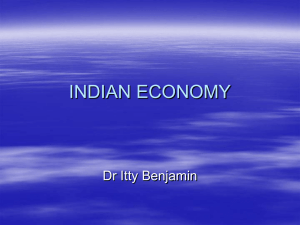
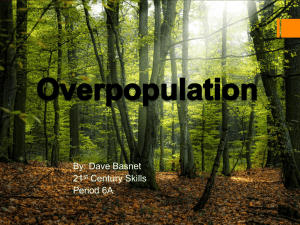
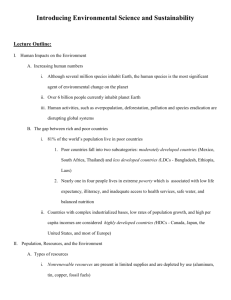
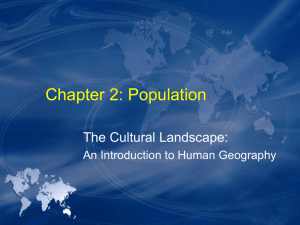
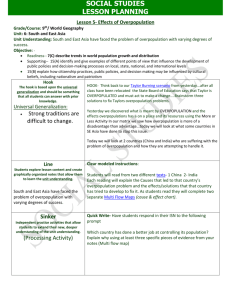

![[标签:标题]](http://s3.studylib.net/store/data/007514640_1-d06ca384d6a6efac05ae8c0c925f8675-300x300.png)